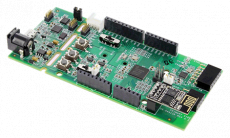Sidebar
- Home
- News
- Training
- Kit
- Stack
- Chip
- Mix
- Project
- IoT

Super User
Renesas Extends Bluetooth 5.0 Connectivity to RA Family of 32-Bit MCUs with Arm Cortex-M Core
Monday, 21 September 2020Renesas Electronics Corporation introduced the first RA microcontroller (MCU) with an integrated Bluetooth® 5.0 Low Energy radio on 07 May 2020. The single-chip RA4W1 MCU includes a 48 MHz, 32-bit Arm® Cortex®-M4 core and Bluetooth 5.0 core delivered in a 56-pin QFN package. Together, the RA4W1 MCU and easy-to-use Flexible Software Package (FSP) enables engineers to immediately begin development with Arm ecosystem software and hardware building blocks that work out-of-the-box with RA MCUs.
The RA4W1 MCU makes it easy for embedded designers to develop safe and secure IoT endpoint devices for Industry 4.0, building automation, metering, healthcare, consumer wearable, and home appliance applications. The MCU is also ideal for developing IoT edge devices for wireless sensor networks, IoT hubs, an add-on to gateways, and an aggregator to IoT cloud applications.
Ti LAUNCHXL-CC2640R2:CC2640R2F wireless MCU LaunchPad™ development kit
Sunday, 20 September 2020Ti SimpleLink™ CC2640R2 SDK_Software Development Kit
Sunday, 20 September 2020The SimpleLink CC2640R2 Software Development Kit (SDK) delivers components that enable engineers to develop applications on the Texas Instruments SimpleLink Bluetooth Low Energy CC2640R2F wireless MCU. This powerful software toolkit provides a cohesive and consistent software experience for all SimpleLink CC2640R2F users by packaging essential software components such as the Bluetooth low energy (BLE) protocol stack, TI-RTOS kernel and TI Drivers in one easy-to-use software package along with exhaustive documentation.
High speed mode
- 2x data throughput
- Faster over-the-air downloads
- Reduce battery consumption
Long range mode
- 4x the range with coded PHY rates of 125 kbps
- Same TX and RX current consumption
- Whole-house coverage
Advertising extension
- Reduce load on advertising channels
- Initiate long-range connections





